The US dollar gained against almost all the other major currencies yesterday and today in Asia, while major EU and US equities slid somewhat. The catalysts may have been fresh concerns regarding the Russia-Ukraine saga and hawkish remarks by Fed Chair Jerome Powell. We also heard from ECB President Lagarde, who said that the Fed and the ECB might move out of sync in the foreseeable future.
Equities Pull Back on Ukraine, USD Gains on Powell’s Hawkish Remarks
The US dollar traded higher against all but one of the other major currencies on Monday and during the Asian session Tuesday. It gained the most versus JPY, EUR, NZD, and CHF, in that order, while it lost some ground only versus CAD.
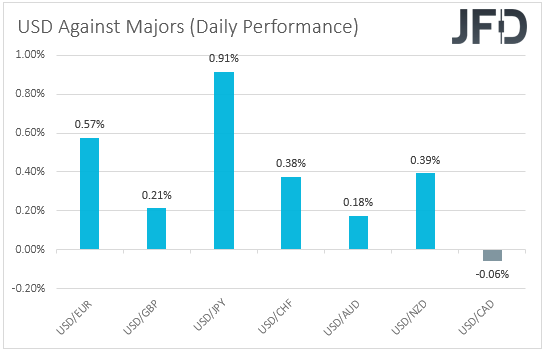
The strengthening of the US dollar suggests that risk aversion may have kicked in yesterday or today in Asia. However, the fact that the yen was the main loser points otherwise. Thus, with the FX market painting a blurry picture regarding the broader market sentiment, we prefer to turn our gaze to the equity world.
There, we see that most major EU and US indices traded in the red, with the exceptions being Italy’s FTSE MIB and the UK FTSE 100. Nonetheless, market participants decided to add back to their risk exposures during the Asian session today.
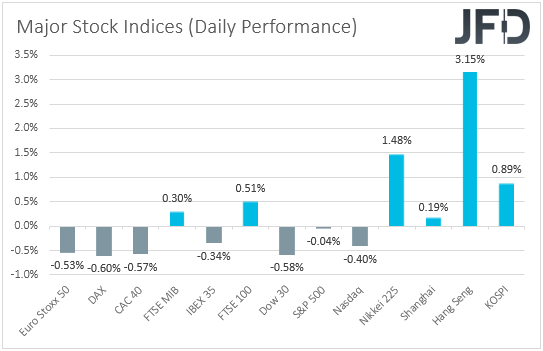
What may have resulted in a setback in EU and US equities may have been a blend of developments surrounding Ukraine and remarks by Fed Chair Jerome Powell. Yesterday, during the early European morning, Ukraine rejected Russian calls to surrender the port city of Mariupol in exchange for safe passage out of the city.
Later in the day, fresh reports hit the wires that the European Union is considering an oil embargo on Russia. EU leaders will meet with US President Biden for a series of summits this week to strengthen their stance against Russia. All this may have been a reason why equities traded lower, and perhaps the main one for the rally in oil prices.
The other driver behind the risk aversion during the EU and US sessions may have been the remarks by Fed Chair Jerome Powell, who said that the Fed must move quickly to bring down too-high inflation, adding that they could use larger liftoffs if needed. These comments may have also fueled the US dollar’s rebound.
We also got to hear from ECB President Lagarde yesterday, who warned that the Fed and the ECB might move out of sync in the foreseeable future, as the war in Ukraine has vastly different effects on their economies.
The main message we got from the latest ECB meeting is that officials were more concerned over high inflation than the effects of the war on the Euro area economy. Still, Lagarde’s remarks yesterday raise questions on that front and whether we will get any rate hike by this bank this year.
Now, as for our view, monetary policy divergence between the Fed and the ECB is likely to keep EUR/USD under selling interest, and we already witnessed that yesterday, with the pair falling back below the round number of 1.1000.
As for the equities, we prefer to maintain our neutral stance about the bigger picture. Yes, we saw a setback yesterday following some concerning headlines surrounding the Russia-Ukraine saga, but yet, it seems that the retreats are not as large as the rebounds and advances we get on positive headlines.
Several stock indices remain above the key resistance barriers they overcame recently, which suggests that we may see some more gains in the short run, but with the war still raging, we cannot call for a long-lasting recovery.
DJIA – Technical Outlook
The Dow Jones Industrial Average cash index traded lower yesterday, but hut support slightly below the 34415 level, staying above the 34120 barrier, which acted as the upper bound of the sideways range that contained the price action between Feb. 21 and Mar. 17. In our view, this keeps the door open for another leg north.
If the bulls are strong enough to retake charge soon, we may see them aiming for the 35070 zone, which provided resistance on Feb. 15 and 16. If they don’t stop there, we are likely to see them challenging the peak of Feb. 11, at 35445, the break of which could extend the advance towards the highs of February 9th and 10th, at around 35870.
On the downside, a dip back below 34120 could signal the return within the aforementioned range and may initially pave the way towards the 33440 territory, marked as a support by the low of Mar. 16. If the bears are unwilling to stop there, we could see them diving towards the 32800 zone, which provided support between Mar. 10 and 15.
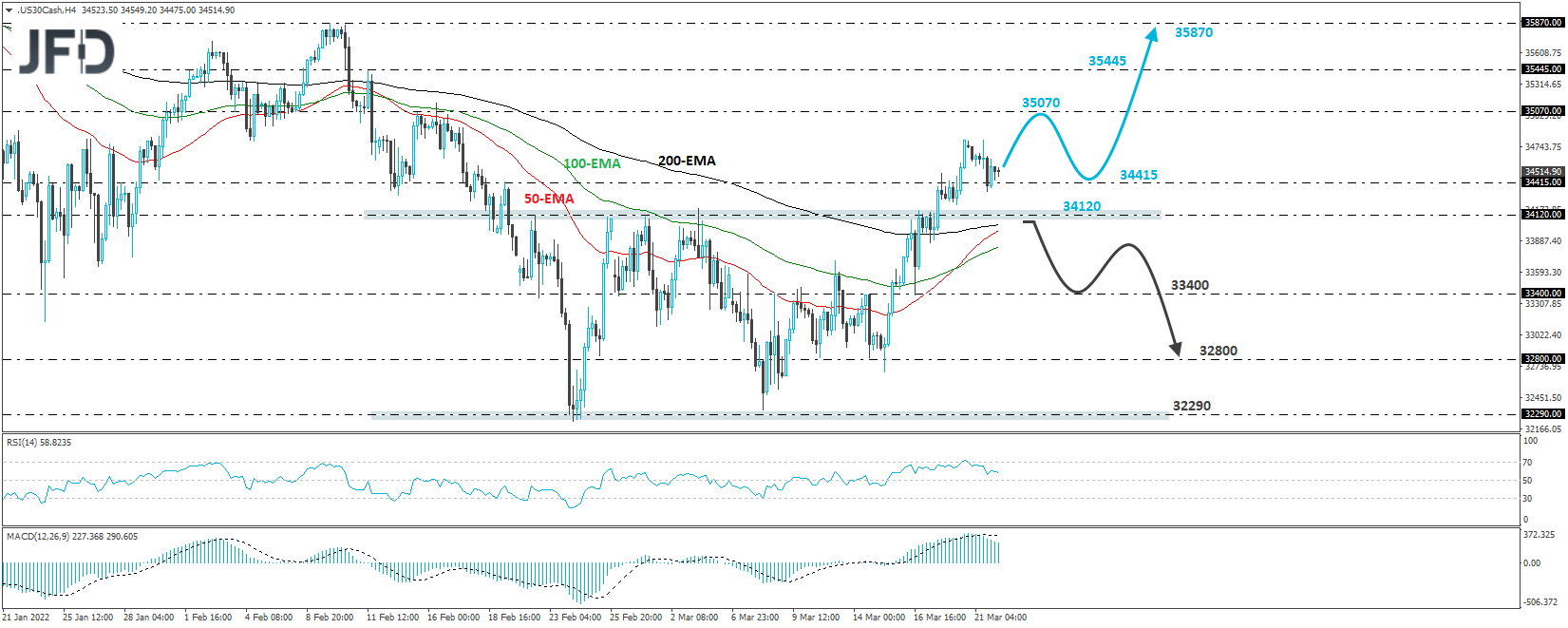
EUR/USD – Technical Outlook
EUR/USD traded lower yesterday, breaking back below the round figure of 1.1000. The slide came after the pair hit resistance near the downside resistance line drawn from the high of Feb. 10 on Thursday, and thus, the fact that it stays below that line keeps the short-term picture negative.
The dip below 1.1000 may have opened the way towards the 1.0925 barrier, marked by the low of Mar. 15, or the 1.0900 hurdle, marked by the low of the day before. However, if neither barrier can stop the slide, a break lower could pave the way towards the low of Mar. 7, at around 1.0807.
On the upside, we would like to see a strong break above 1.1145, the high of Mar. 2, before examining whether the outlook has turned overly optimistic. This could confirm the break above the downside resistance line drawn from the peak of Feb. 10 and may see scope for advances towards the 1.1235 zone, defined as resistance by the peak of Mar. 1.
Slightly higher lies the 1.290 zone, which acted as strong support on Feb. 14 and 22, the break of which could set the stage for extensions towards the 13.65 hurdle, or the 1.1395 obstacle, marked by the peaks of Feb. 23 and 16, respectively.
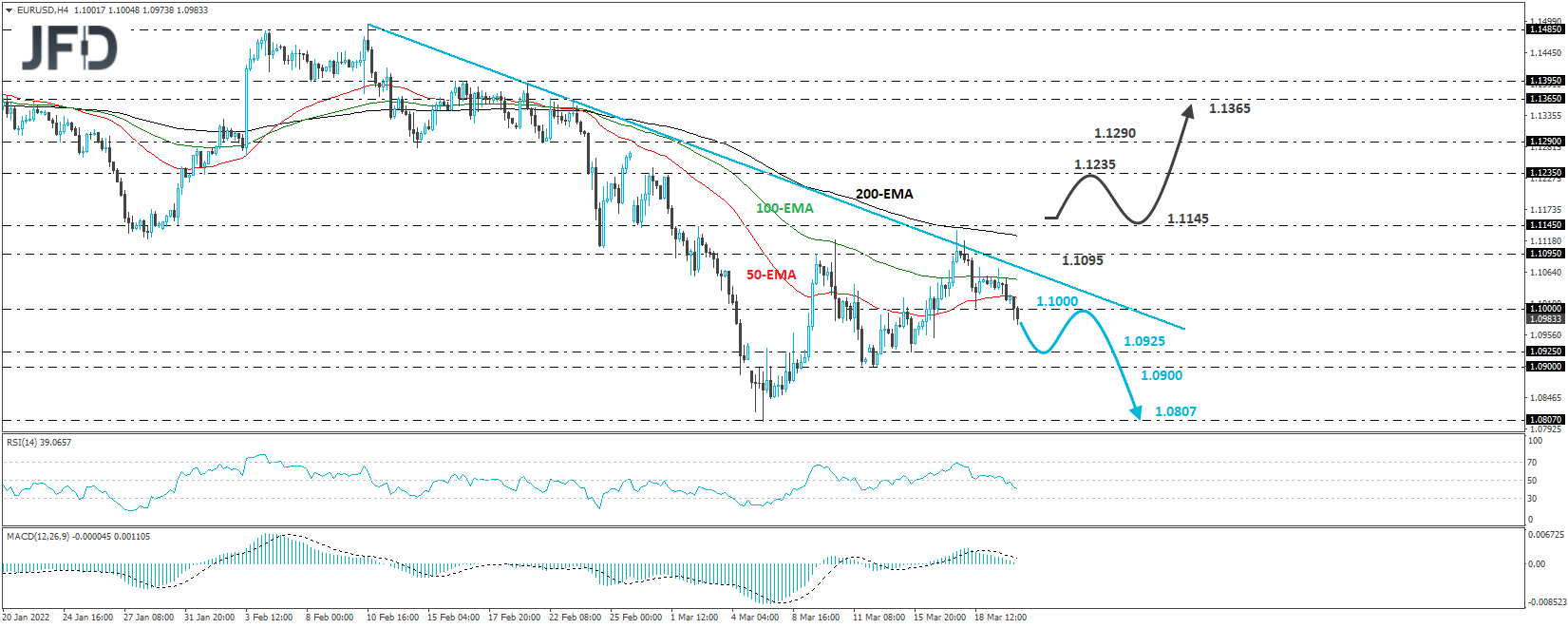
As for Today’s Events
The calendar appears very light today, with no significant data releases on the agenda. However, we will hear from several monetary policy officials, including ECB President Lagarde again, SNB Chairman Thomas Jordan, Fed’s Williams, Mester, and Daly, as well as BoE member Cunliffe.
Tomorrow, during the early European session, we have the UK CPIs for February, with both the headline and core rates expected to have continued rising. Specifically, the headline rate is forecast to have inched up to +5.9% YoY from +5.5%, while the core one is forecast to have risen to +4.8% YoY from +4.4%.
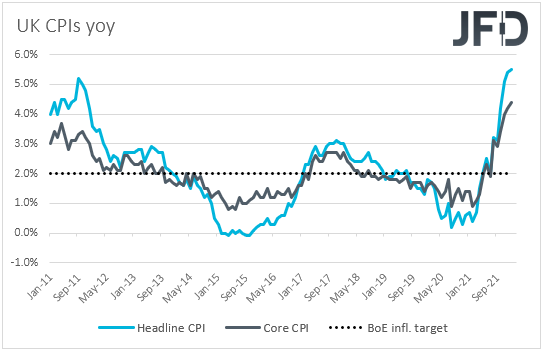
At last week’s meeting, BoE officials decided to hike interest rates by another 25 bps via an 8-1 voting, with the dissenter calling for no increase at all. Remember that officials lifted rates by 25 bps at the February gathering, but the vote was 5-4, with the dissenters calling for a 50bps increase.
Compared to that, last week’s decision reveals a more cautious approach by policymakers. It raises questions about whether they will proceed as aggressively as the market had been pricing in heading into the gathering.
That said, accelerating inflation further above the bank’s target of 2% could revive expectations that the bank may need to act more quickly, which could prove supportive for the pound.
